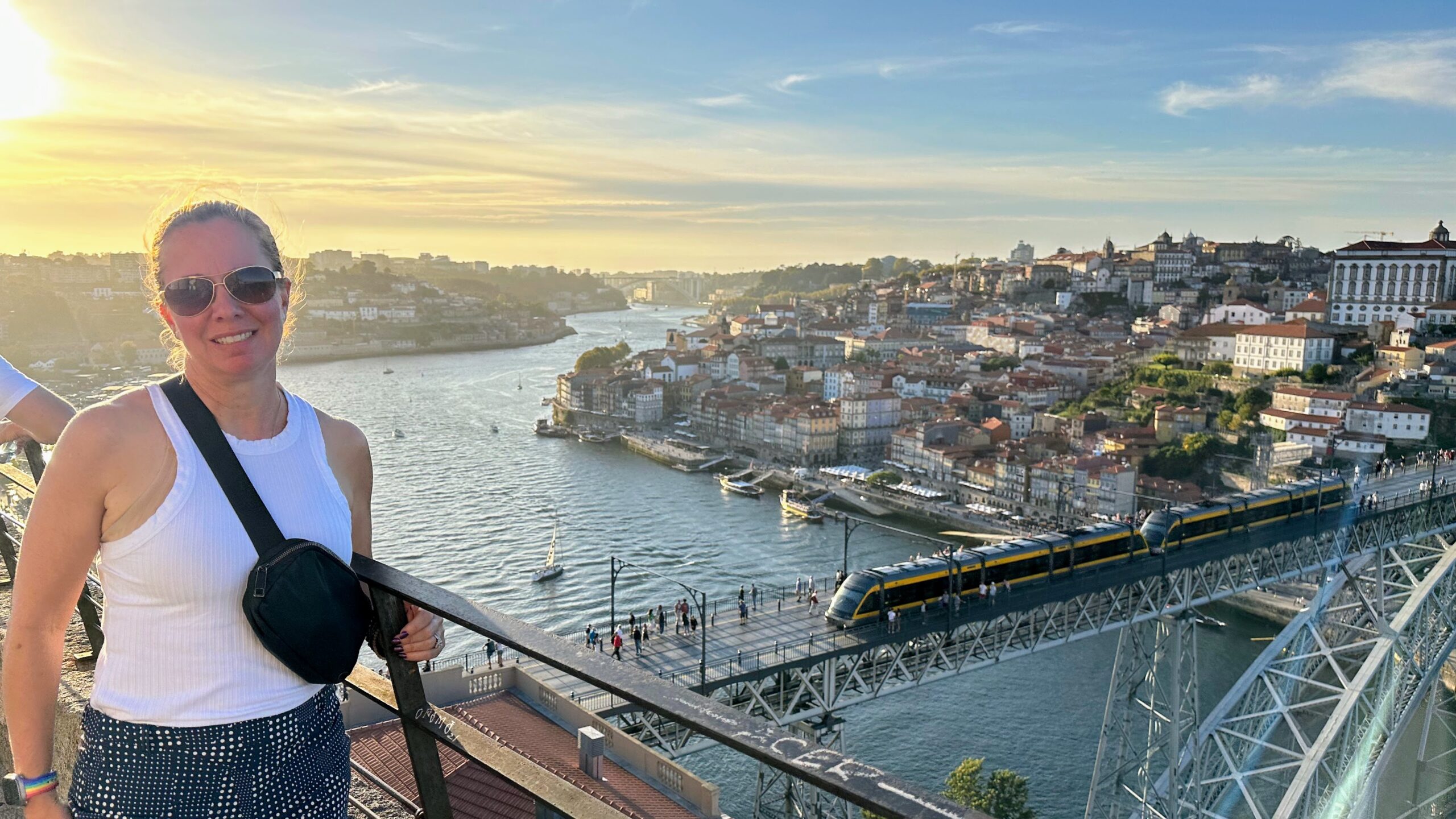While breathtaking views, plentiful cafes, engaging people, and a mix of old- and new-world charm would normally be enough to make a vacation great, we found something everywhere in Portugal that tied our experiences together.
It was the energy.
After a few years off from exploring Europe, it was refreshing for our first trip back to end up someplace where tourists and locals alike seemed happy and energized in each other’s presence. (No doubt, the energy was also helpful for overcoming some severe, age-induced jet lag.) Portugal feels like a place where residents don’t mind living their lives among and on display for visitors. It made for a welcoming rather than a disorienting arrival which only got better as the trip continued.
The best-laid plans … and a surprise excursion
Next to travel itself, one thing I really enjoy is the planning the logistics of getting from place-to-place. Nothing beats basking in the glory of a travel plan well-executed at the end of that first, long day. We had a great plan coming into Portugal: land in Lisbon, ride the metro to the train station, hop a fast train to Lisbon, and take a car to our hotel in the Douro Valley. Our plan got us all the way to the train station in Lisbon.
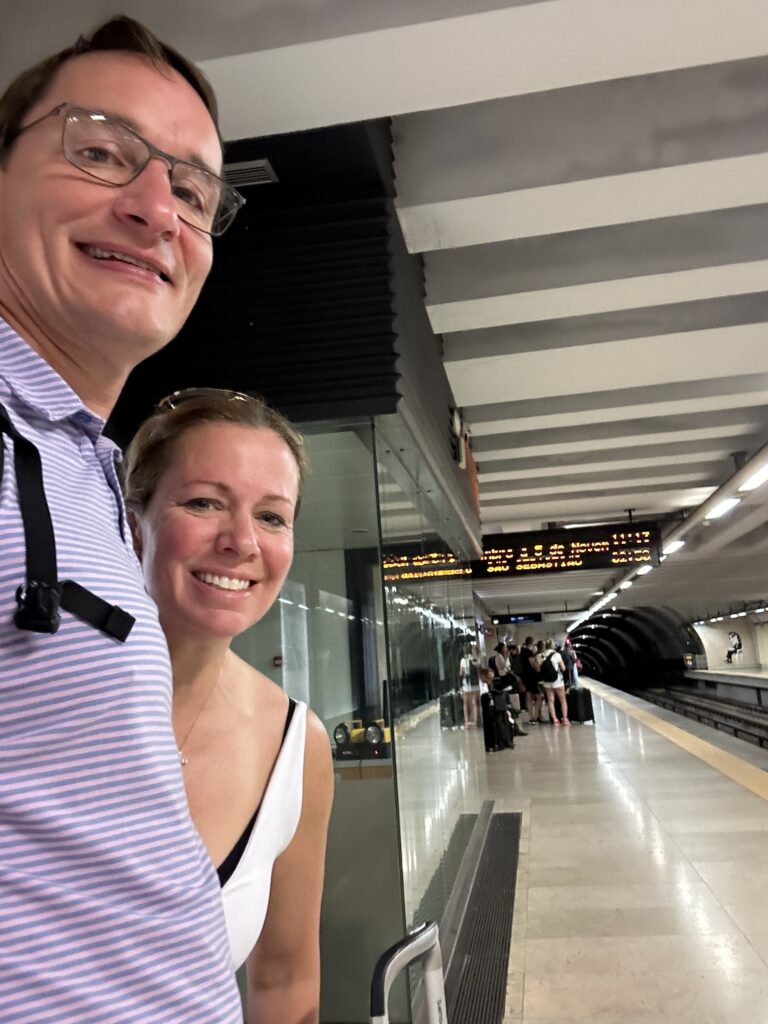
Based on prior experience with timing and train occupancy, we decided to wait to buy train tickets until we got to the train station so we could accommodate any delays. What we hadn’t anticipated was how popular the trains would be on this particular arrival day. After some frantic, unsuccessful experiences trying to use the Portugal trains app, I found a somewhat sympathetic ticket window worker who explained all trains were sold out until late in the day. Our planned afternoon arrival at the hotel would instead be late in the evening at best.
Luckily, we were able to find a rental car agency right inside the train station that could help us out. Thirty minutes later, we were on the road (albeit in the last automatic transmission vehicle they had left). While we would miss the welcome rest from the train ride through the Portuguese countryside, we decided to make up for it by visiting a spot we originally thought we’d miss… Nazaré!
Spotting for 100-foot waves
All over the streaming channels are documentaries about people who make crazy sporting feats seem reasonable. My wife Caitlin introduced me to 100 Foot Wave, the HBO series focused on professional surfer Garrett McNamara and his journey to Nazaré, Portugual in pursuit of monster waves. We enjoyed learning his story and watching the stunning video of tiny people surfing on waves the size of office buildings. While neither of us surf, we loved the idea of visiting and experiencing first-hand what we’d previously only seen on screen. Plus, it’s location was a perfect halfway point on our way north–what a perfect place to inspire our own adventures for the week.
Upon arriving in Nazaré, we quickly learned that Google Maps has a hard time navigating medieval streets. After a few laps, we found a spot, parked the car, and continued on foot through the lovely square in front of the Sanctuary of Our Lady of Nazareth. This area was our first taste of the energy in Portugal–people were everywhere, visiting market stalls, enjoying free tastes of candies and freshly roasted nuts, and sitting in a variety of cafes offering fresh seafood and stunning views. We bought some snacks and quickly made our way to the coast.
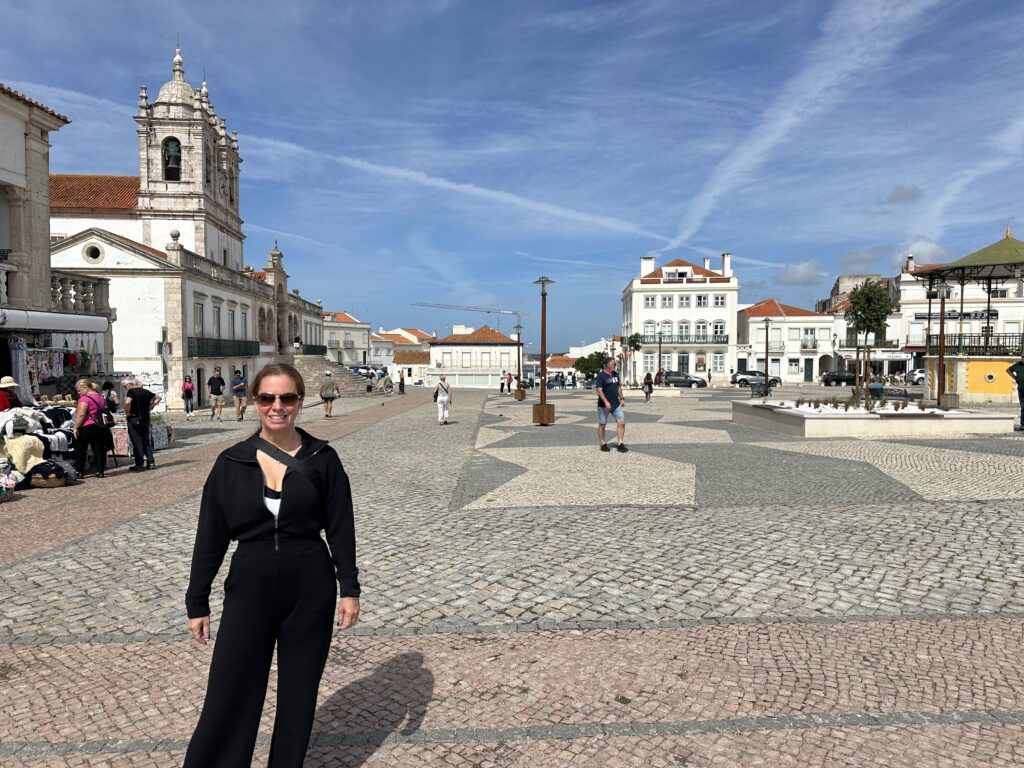
The star attraction of Nazaré is the Forte de São Miguel Arcanjo (Fort of St. Michael the Archangel). Or, more appropriately, the star is the view from the fort. For a couple euros, one can tour the fort whose worn, rocky interior now features a couple galleries dedicated to the surfers of Nazaré. After climbing up narrow staircases, one is immediately rewarded with an elevated, panoramic view of the coast. Peering over the barely knee-high parapet, one can see giant rock formations below where the massive waves break.
We sat and watched the waves up and down the coast for awhile, noting the contrasts between the calm Nazaré Beach to our south and the much wilder looking North Beach. After some research, we found out that the big waves at Nazaré are caused by the presence of an underwater canyon with a depth of up to 16,000 feet (the largest in Europe). The canyon basically allows waves to travel all the way to the North Beach coast unabated. As the conditions of the currents change, the ocean can create waves that break over 100 feet.

While we didn’t see any 100-foot waves, we couldn’t pull ourselves away from watching the power of nature. The combination of breeze, sun, and crashing waves below was rejuvenating after all the time spent in airplanes and in the car. On our way back up we stopped and grabbed a couple beers so we could spend just a few more minutes absorbing it all. What a great, though unexpected, first stop!
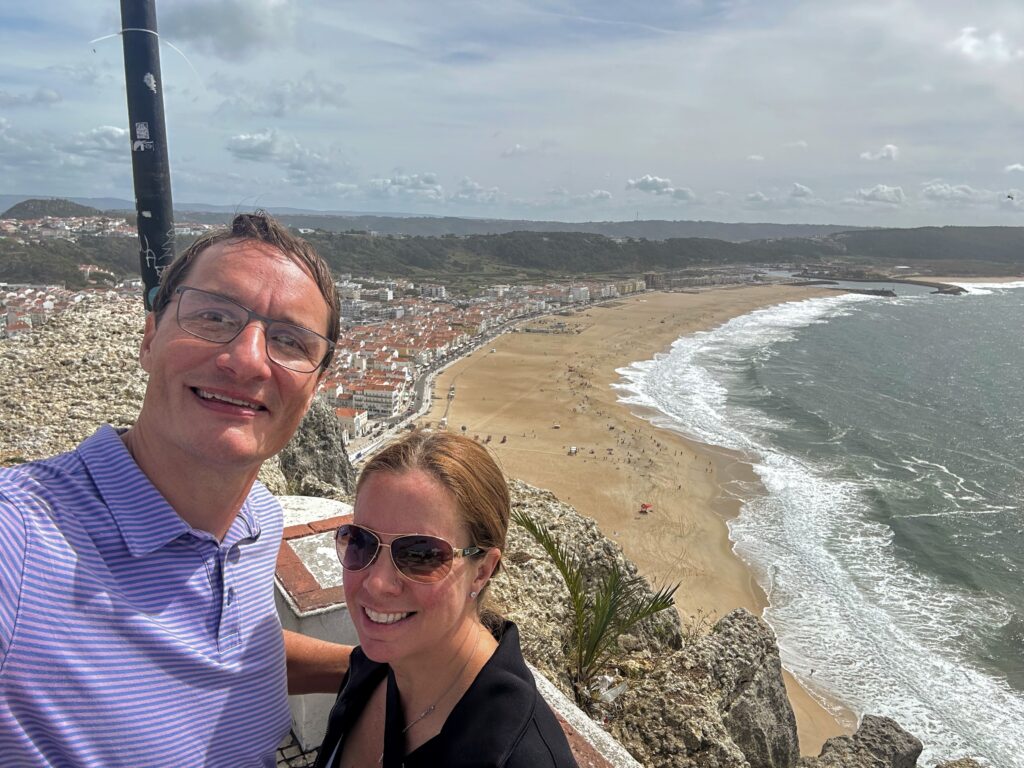
The Douro: our kind of lazy river
Refreshed from our visit to Nazaré, we got back in the car and headed to the Douro Valley. We would be spending a couple days enjoying the serenity of the top wine region in Portugal before spending the remainder of the trip in cities. Skirting Porto, I got a nice taste of driving on windy, mountain roads (much to Caitlin’s chagrin) before ending up at our hotel, the Octant Douro.
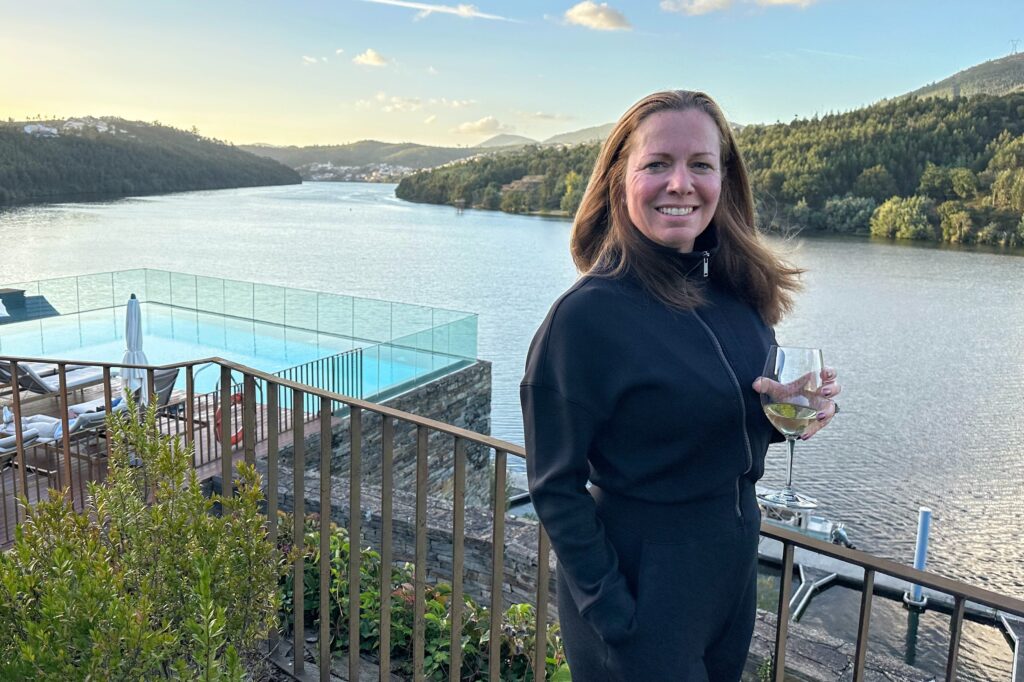
The Douro River starts in Spain and winds its way through the northern part of Portugal before letting out into the Atlantic Ocean at Porto. We chose our hotel because it sits directly on the river, built into the side of the mountain in an effort to preserve the natural landscape of the area. This turned out to be great because while the hotel was nice, windows everywhere revealed that the real star of the show was the river and its surrounding hillsides.
The river carved immense valleys through this hilly region. Upon discovering the climate was perfect for growing grapes and making wine, people reshaped the land into terraces that create a unique texture up the lush hillsides. Grapes grow everywhere–on the terraces, along the valley floor, even in backyards. Eventually, the river was dammed for hydro power taming the Douro into the wide, flat giant that it is today.
We spent our entire visit at the hotel, enjoying the view of the river as much as possible. Day trip boats and river cruises would go back-and-forth, with us watching them watching us. Personally, I was pretty happy to be anchored to this beautiful spot, enjoying our first tastes of the local cuisine and wine. Our favorite memory was a special dinner put together by the hotel on its top terrace, well over 80 feet above the river below.
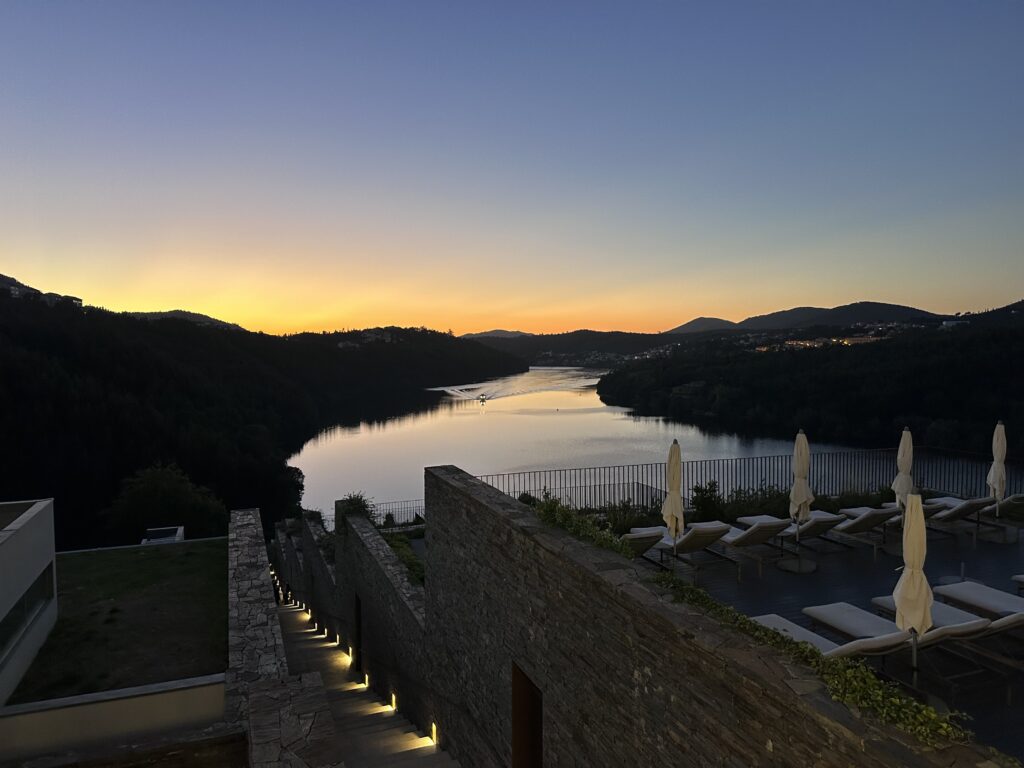
Again, I felt energy, this time building within us. In our lives back home, we don’t get much time that isn’t filled by something else. It was great to show up someplace where there were no plans, surrounded by beauty and a warm culture that made us feel great about our choice to come to Portugal.
Time melted away, and it was time for a transition from tranquil countryside to the buzz of a city. However, we decided to have one last adventure in the Douro Valley.
Douro hike: how far can 11km be anyway?
We like to hike wherever we go. Upon arrival, the hotel delivered to us a local “adventure” guide featuring several nearby hiking trails for a richer taste of the area. A majority of the trails were very recently created and are now maintained by PayváPé, a group of volunteers dedicated showing the most incredible parts of their local area.
Besides providing overviews of sights along the way and handy turn-by-turn GPS files, the site also posts reviews and current trail conditions. If you follow in our footsteps, please note that several of the trails had been vandalized recently with the trail markers removed. While I normally have great faith in Google Maps and my internal GPS, to prevent potential disappointment I decided to go with a trail where the markers were posted in excellent condition: PP03 Sardoura.
The Sardoura route promised a slice of local life, beautiful vistas, varying heights, and historical sites. And, at 11km, it offered to fill our afternoon with a nice lasting impression of Douro before heading into the cities.
We started just before lunchtime at the trailhead in Santa Maria de Sardoura, standing right in front its humble chapel. Given that it was Sunday, it was not surprising to find the town quiet–in fact, during the rest of the hike, we only encountered a few other people. We started down the first part of the trail which was religiously marked with cute little blue triangles with arrows.

The hike meandered up through the village, between backyards and under grapevines. We quickly reached the highest point of the hike which offered 360-degree views of the valley, the river, terraces, and little villages dotted throughout. The best part was a swing (for which I highly recommend one person at a time) where you could rest for a moment while enjoying the view.
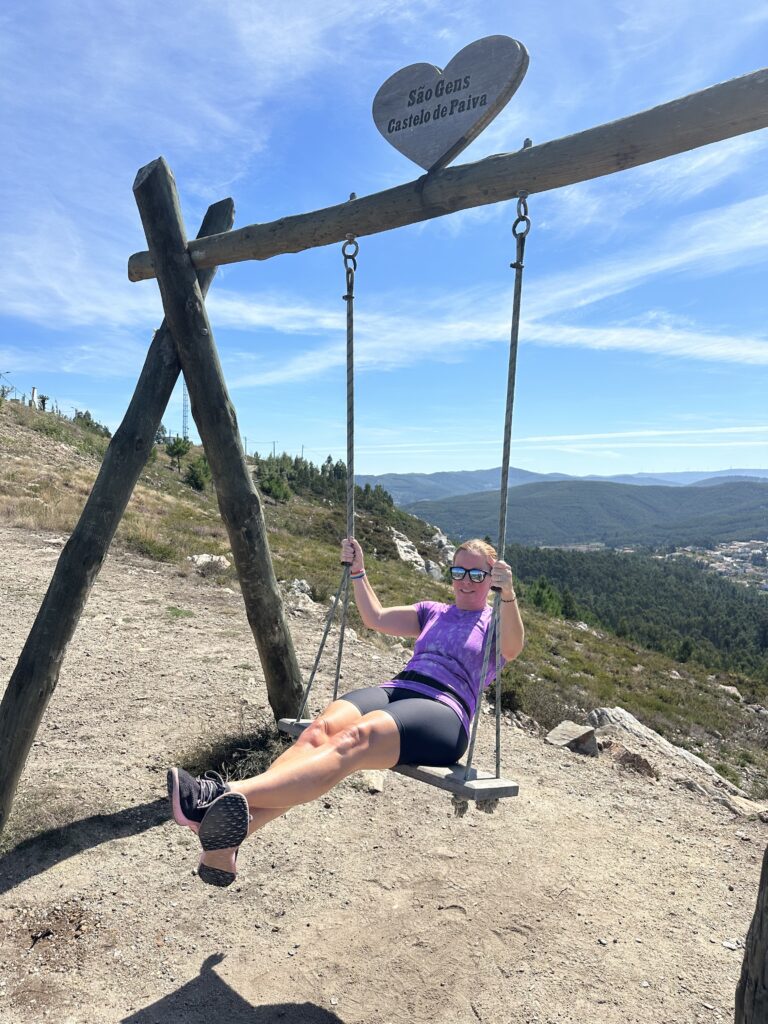
After descending, we enjoyed a twisting trail through forests, tiny villages, and endless vineyards. We would occasionally hear voices of families relaxing in their homes on a beautiful Sunday afternoon, but it was mostly peaceful. I only steered us off course one time, ending up in a muddy creek that I swore Google Maps said was part of the path. Luckily, Caitlin was patient with me as we found our way back to the trail marking I missed.
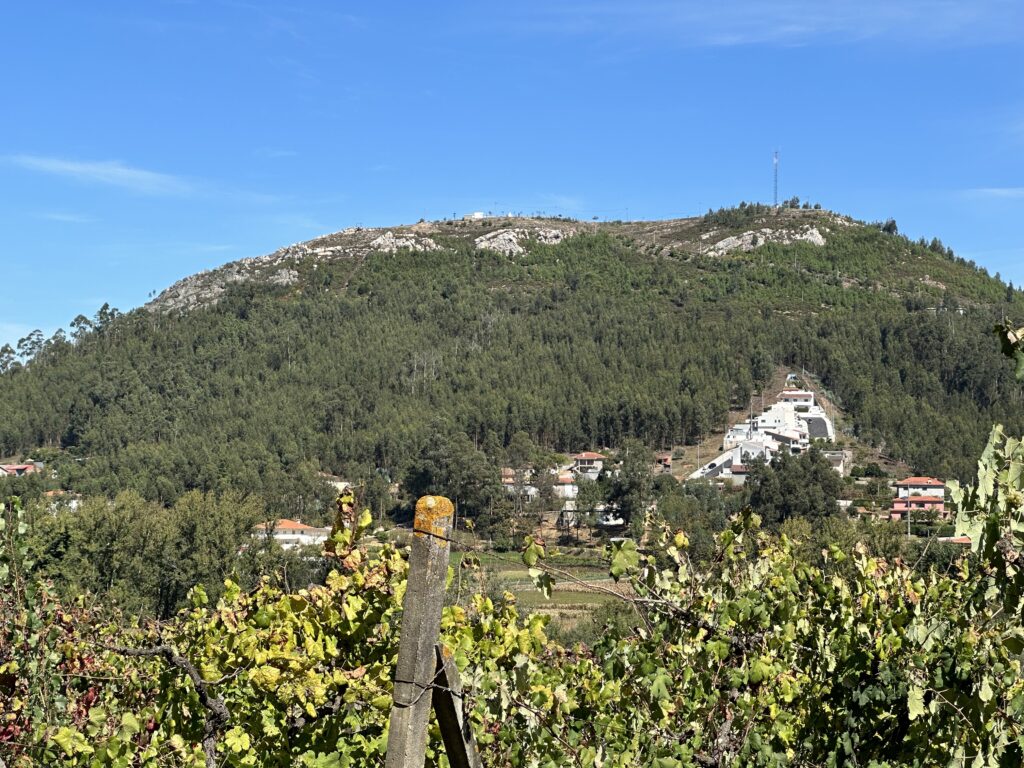
We enjoyed the endless views and the taste of country life in Portugal, but at the eighth kilometer we could see the car and decided to cut the hike short. The sights hid the sneakily up-and-down nature of the trail. However, we had seen plenty and gotten a nice workout.
A tiny little cafe greeted us near our car. We enjoyed sipping on a couple tiny beers while listened to a group of local men banter in Portuguese. Every few minutes another would arrive. Eventually, the cafe server brought out a bottle of wine with about seven glasses for their group. We found that energy again in being part of that scene, enjoying that we’d all ended up at the same place to enjoy that lovely afternoon. We waved goodbye and got in the car for Porto.
Porto: a bustling, buzzing, medieval maze
If the Douro Valley was the equivalent of the lazy river ride at the waterpark, Porto was the extreme rafting waterslide where you couldn’t wait to get around every corner. After dropping the car off at the airport, we rode the metro which allowed us to emerge from underground right up into the middle of the transformed medieval old city.
First observation: people were everywhere! Tourists hauling suitcases (like us), students darting home from school, merchants pitching tours, and bystanders enjoying it all from their cafe tables which seemed to line every visible alley. What a smacking contrast from the peaceful days along the Douro, but I immediately felt the energy of this new and wonderful place.
Second observation: every direction appeared to go uphill! As background, Porto, especially the old world parts where we planned to spend our time, is built right into the hills that line the Douro River right before it lets out into the Atlantic. While all the online research advised that walking around (or, more appropriately, up and down) Porto was not for the faint of heart, we weren’t quite prepared to be thrown right into the city walking equivalent of black diamond ski trails.
To add to the challenge, I was not quite ready for how Google Maps handled steep changes in altitude or alleyways hidden under staircases. While our original walk from the metro to our vacation rental was estimated at seven minutes, we spent about a half hour battling wrong turns, going up when we should have gone down, and a few circles around the same block. Breathless, we finally found the front door to our rental and were rewarded with one of the best imaginable views for our stay.

We had a nice terrace one again overlooking the Douro River. This time, however, the river was flanked by lovely multi-colored stone and plaster buildings with red-tiled roofs meandering up and down the various hills. Immediately to our left was the imposing Dom Luís I Bridge, a metal bridge supported by a giant arch featuring two decks: one up top which supports foot traffic and the metro line, and the bottom which also handles foot traffic with the occasional vehicle. The bridge, whose construction was overseen by a disciple of Gustave Eiffel, opened to traffic in 1886.
Along the far side of the river we could see buildings with large, lit-up signs featuring the names of major port wine producers. These buildings, in a city known as Vila Nova de Gaia, are where much of the port wine is stored and aged before being shipped off to the rest of the world. Even from our high vantage point we could see the umbrellas of cafes dotting the riverfront in between the port producers. We couldn’t wait to get out and explore!
Since we arrived late in the day, we decided to spend the first night exploring the riverfront. With a better understanding of how to use Google Maps to handle the twisty, narrow medieval roads, we found our way down to the busy scene along the Porto side of the river. We were rewarded with dozens of restaurants, street entertainment, and merchants along the pleasant pedestrian-only Cais da Ribeira.
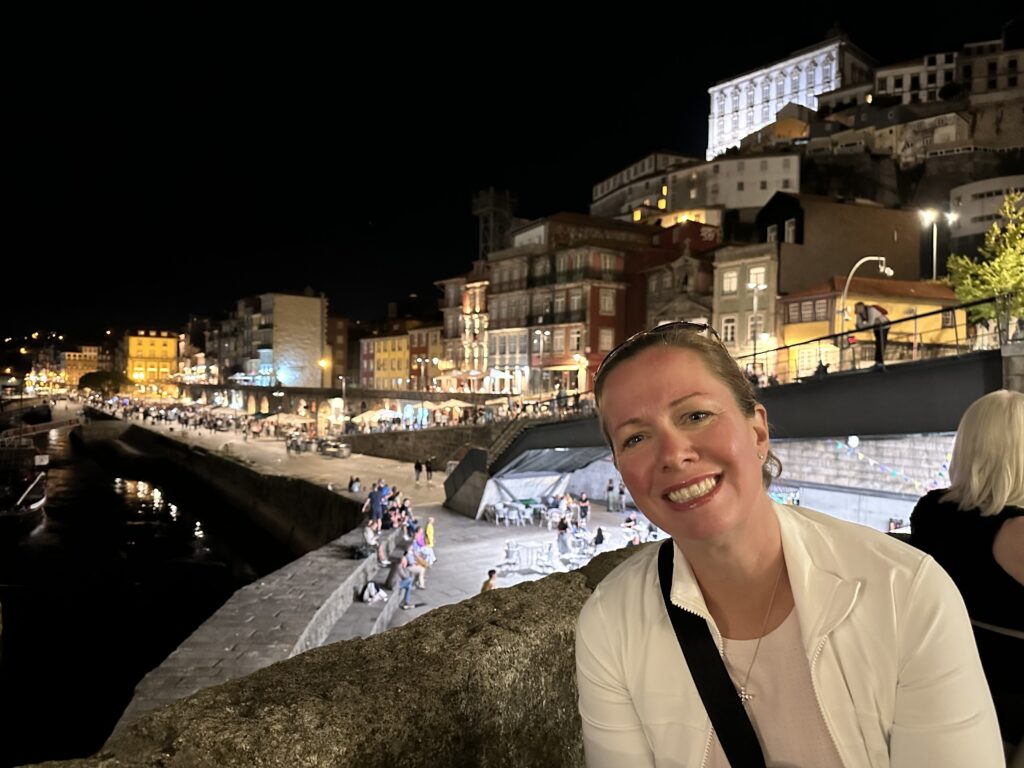
While sometimes busy places can be frenetic and draining, we enjoyed weaving between all the people taking in the sights and sounds of this fall evening. With some help again from Google Maps and its restaurant ratings, we ended up at Terra Nova, sitting at a tight but perfectly positioned table right along the Cais da Ribeira. Seafood is featured prominently at many of the restaurants in Porto, and reviewers said Terra Nova consistently rose above its more tourist-trappy neighbors for its food.
We were not disappointed. We ordered a few items to share: a sautéed cod dish with homemade pasta noodles and garlic tomato sauce, a shrimp risotto, and burrata for an appetizer (which we almost never can resist). The food was delicious and fresh, and we were treated to scene along the riverfront for the two hours we spent at the restaurant. While plenty of people lined up to eat at the restaurant, we were never rushed during our meal.
After all the (literal) ups-and-downs of the day, we decided to call it a night and headed back uphill one last time to our vacation rental. I think we were both asleep in about 10 minutes!
Too much for two days: wandering Porto
Our original plan was to follow the Rick Steves walking tours for Porto as a starting point for our explorations. Caitlin and I have an understanding that at any time we can peel off the guided tour, linger at will at a stop along the way, or abandon the tour altogether and follow our hearts (and, sometimes, our noses). We ended up mostly wandering back-and-forth across the city, referring back to the guide when helpful or interesting.
Porto is an ideal kind of place for wandering. Once you get used to the layout of the main neighborhoods, it’s not too hard to find your way back to a center point and start journeying in a different direction. I would say one of the best parts of the place is that one doesn’t have to go very far to find an interesting place to eat, drink, shop, or people-watch.
Porto, like many cities, features neighborhoods that each have their own distinctive layout, architecture, and vibe. On our trip, we decided to focus on two main areas:
- Ribeira: Our vacation rental sat near the top of the hill that frames this historical area which runs all the way down to the riverfront. The tight, meandering cobblestone streets run between buildings that have survived for centuries.
- Baixa: At the top of the hill and towards the city center, Baixa features larger buildings along wider streets. The area buzzes with bars, restaurants, shops, and other city services.
While we did wander into Gaia and Cedofeita, there simply was just too much to see and do in Porto in just two days. Plus, we really wanted to stay on foot so we did not want to get too far away from our vacation rental. So, off we went with our guidebook, Google Maps, and that all-important sense of smell.
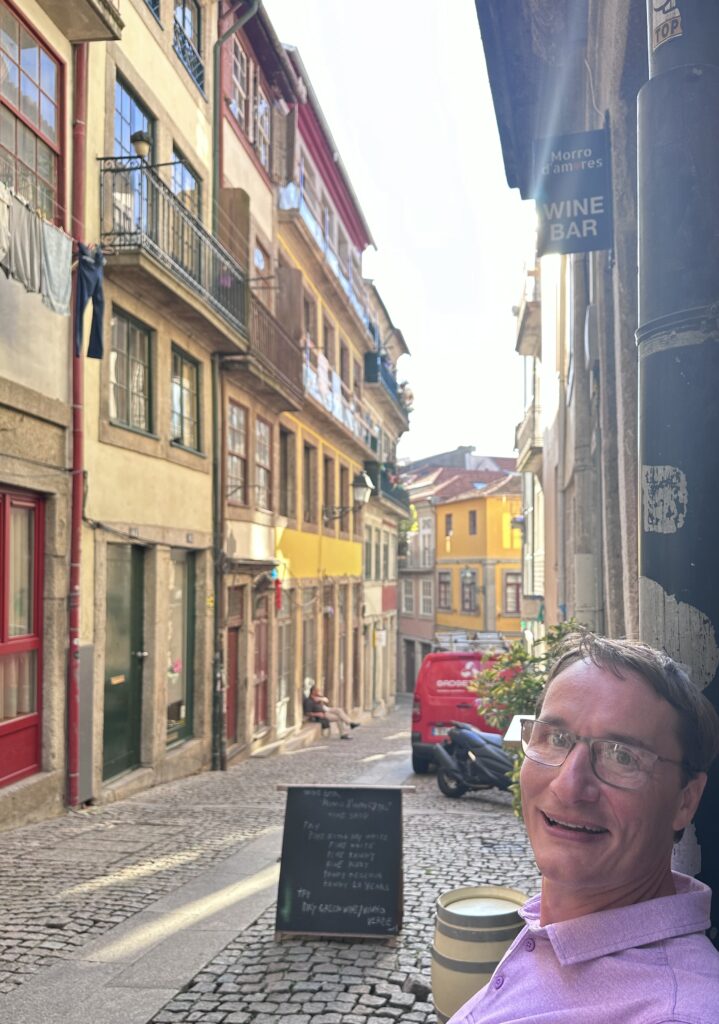
The next two days were a blur of movement, eating, drinking wine, and watching the wide variety of people. Our watches registered well over 15,000 steps each day–more importantly, I believe we recorded many hundreds of feet of vertical climb each day. An occasional Super Bock (for real, that’s the name of the beer in Porto) helped quench our thirsts after all that walking. We saw and experienced so much, but there were a few highlights that stick out:
Getting lost. On purpose. Some of our best finds in Porto were tucked into unmarked, dark, or barely visible alleys. An example of such a find was the Alibi wine bar, featuring an outward-facing bar perfect for watching pedestrian traffic. We could have sat for hours in our little corner perch–only after finding the link above did I realize it has an amazing rooftop terrace and restaurant attached. We’ll have to go back and check it out. As another example, one of the best meals of the trip came after a few random turns popped us out into a busy but mostly unmarked cafe called Gharb. The hummus and lamb kebab were delicious, and we definitely understood why the place was so crowded. I am starting to think a good trip can be measured by the number of wrong turns that turn into awesome memories.

Afternoon drinks on a parking garage. More exactly, Base is a beer and wine garden within a pretty park that hides an underground parking garage. Billed in the reviews as “the place where nights begin”, at our age and activity level, it was more like the “place where the end of the night begins.” Caitlin and I are both suckers for beer/wine gardens, and this goes near the top of the list for favorite outdoor hangout spots in the world. We may have come back a couple times over the course of our two days (sometimes you just need a good place to rest after all that walking).
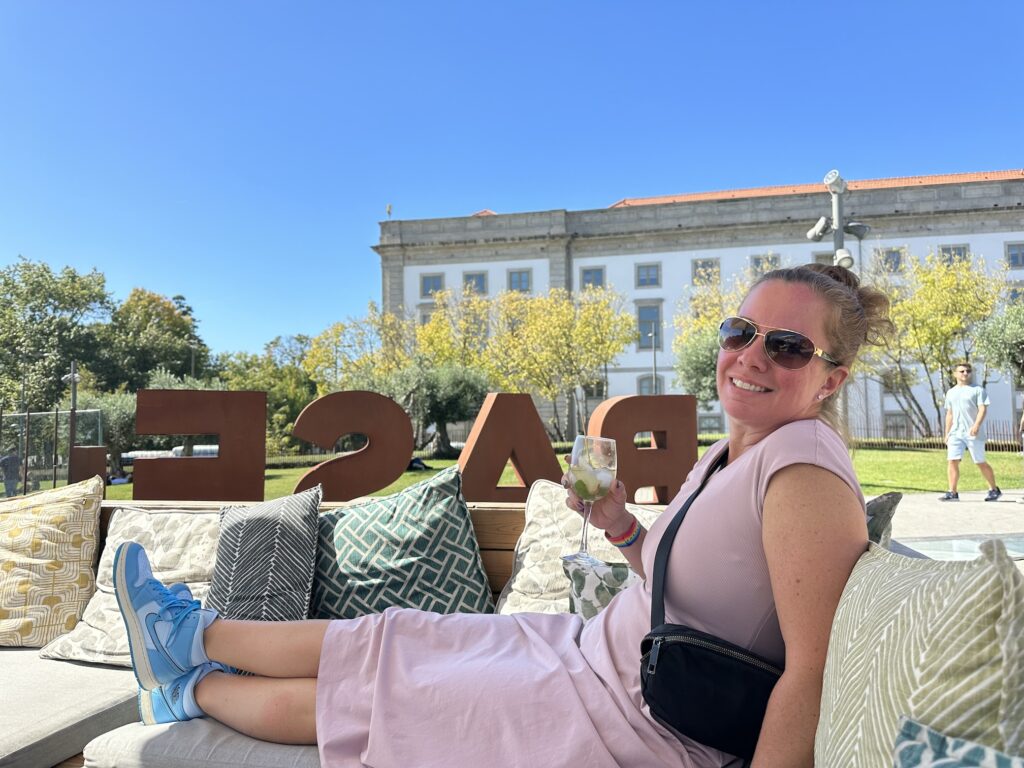
One probably shouldn’t visit this market on an empty stomach. The Mercado do Bolhão, recently remodeled, is an open-air market in the center of Baixafeaturing numerous stalls selling fresh produce, seafood, spices, and sweets. We could’ve stocked hundreds of picnics and not eaten the same thing twice! We walked up and down the rows where vendors were happy to provide samples and describe items that we didn’t recognize. While temptation was everywhere, we managed to make it out of there with a bag of sweets and snacks.
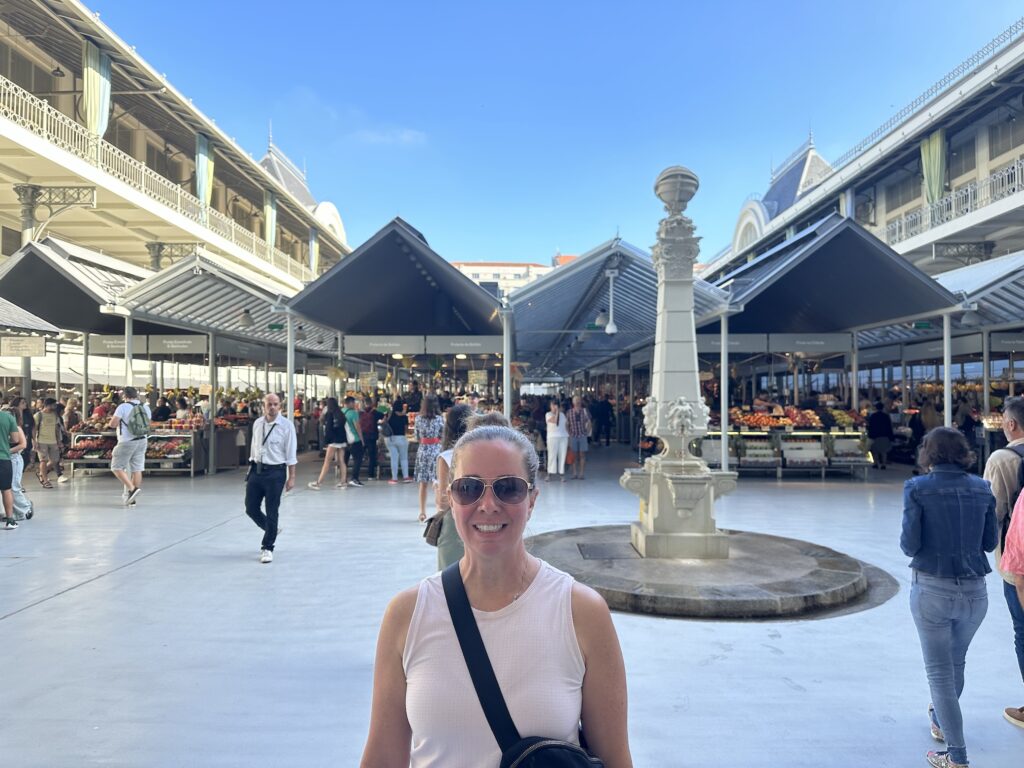
A mystery dinner. Scrolling through the dinner options one night, I stumbled upon a new-ish place near our vacation rental that was getting great reviews. Barrica sounded like our kind of place: farm-to-table, chef-driven small plates with optional wine pairings. Even better, they offer a “surprise” option, where you are given a sealed envelope with the chef’s selections (which change every day) that you can choose to open or leave sealed until the end. Our server gleefully helped us deduce each course’s flavors and ingredients, cheering us on when we guessed correctly. It was one of the most unique restaurant experiences we’ve had, and the meal would have stood on its own even if we’d known what we were getting ahead of time.
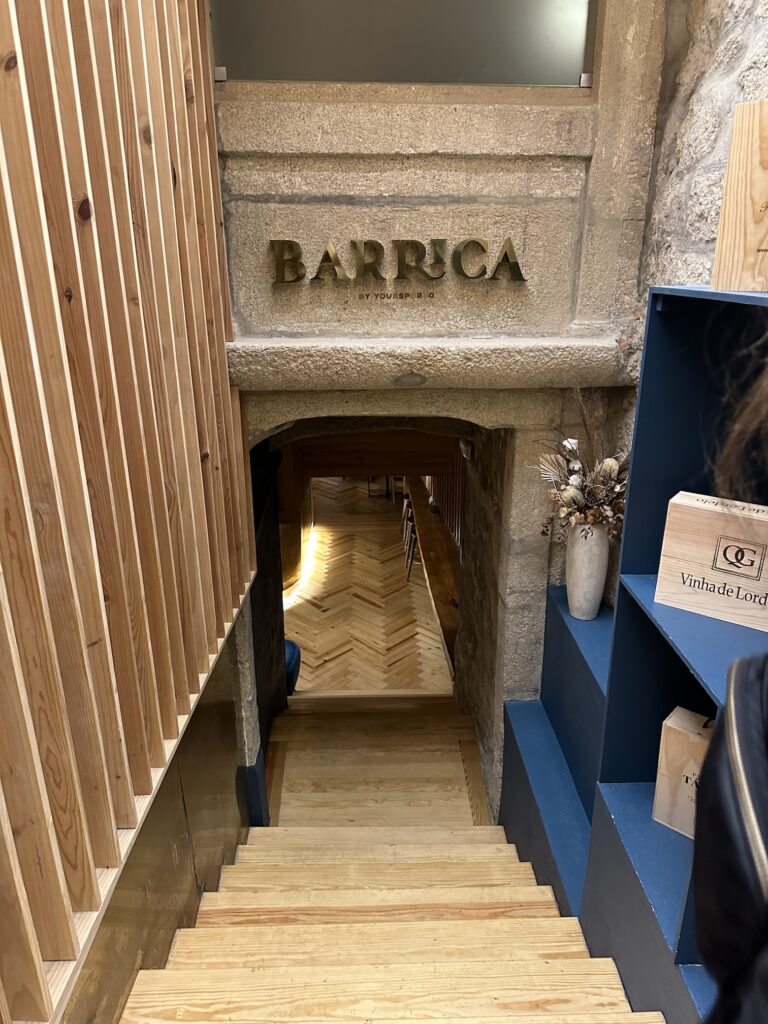
- Watching the sunset over Porto from Gaia. Each night, we had seen crowds gathering for sunset at a hilltop park across the river. We wanted to check it out for ourselves, so we wrapped up the last afternoon in Porto by walking across the bridge and strolling by the various cafes and port wine tasting rooms in Gaia. Conveniently, a gondola whisks visitors from the end of the Gaia river district right into the middle of the park. That feeling of energy was strong with the sunset crowd–kids dancing and running around, couples picnicking, and musicians performing all contributed to the atmosphere of the evening. We enjoyed seeing Porto from a high vantage point, the fading sunlight cycling the hues of the numerous colored buildings on the hillside. This was the image of Porto that would be impressed on memories.
I always like to imagine what it would be like to stay in a place like Porto for a week or a month. While a couple days gave us a good feel for the place, there is so much more for exploring. This is a charming, old city that is growing and refashioning itself to handle increasing interest from visitors like us. Caitlin came up with a philosophy that we really like for places like this: act like you’ll be back. With Porto, it’s nice to think someday we will return to see plenty of new things and revisit some familiar favorites.
Lisbon: more than a footnote, less than 24 hours
On the day before going home, we took the fast train (booked well in advance this time) from Porto to Lisbon. We had reserved a hotel room right in the center of the old city, our room overlooking the Praça dos Restauradores, featuring a giant obelisk commemorating Portugal’s independence from Spain. The location was perfect for an afternoon traversing three of the most interesting neighborhoods that span the valley of old Lisbon.
With our plane leaving the next morning, we did our best to get a feel for Lisbon, a larger and more metropolitan feeling place than Porto. We had a lovely time people-watching in a few more cafes, walking up into a medieval citadel dating to the 11th century, and enjoying the diversity of the few neighborhoods we got to visit. The highlight of the last night was dining at Bairro do Avillez, one of several restaurants by famed Portuguese chef José Avillez (I’m a sucker for celebrity chefs). The series of modern twists on traditional Portuguese food provided a perfect culinary ending to our trip.
